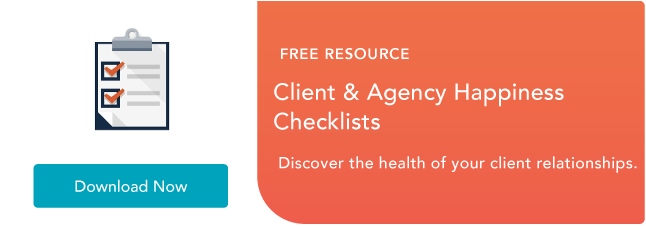
A firm handshake, a friendly tone of voice, a patient nod -- all of these things can help make your client feel comfortable and understood in a face-to-face setting.
But how do you nurture positive client relationships when face-to-face contact is more often than not replaced by inbox-to-inbox exchanges?
When the emphasis is on plain text, the way you phrase your sentences and questions is more crucial than ever. These seven shifts in the way you communicate with clients may seem inconsequential, but they can have a massive impact on the way your clients perceive your agency's value.
1) Use "we" instead of "I" to position yourself as a member of the client's team.
Instead of: "I'll get working on developing your buyer personas."
Say this: "We can get to work on developing our buyer personas."
At the end of the day, you and your client are both working towards the same thing: their success. When you use "I" to discuss a task or a goal, it subtly positions your agency as a third party. Using "we" fosters a collaborative discussion where you and your client are both on the home team. This creates an "all for one" mentality that can improve the bond between your agency and the client, minimize conflicts down the line, and keep everyone on the same page when it comes to project goals and expectations.
2) Limit your use of "you," especially in situations that have the potential to escalate into conflicts.
Instead of: "You told me that those posts needed to be ready by Thursday."
Say this: "Based on our last email exchange, I was under the impression that those posts needed to be ready by Thursday. Let me know if anything has changed."
Nothing intensifies a simple misunderstanding into a full-blown conflict like firing off a "Well, you said..." in a client email. Using "you" in a tense interaction draws a clear line in the sand -- you versus me -- immediately unraveling any precious progress you made aligning yourself on the client's team.
When it comes to navigating points of friction with a client, the best thing to do is avoid pointing fingers at all costs. Assigning blame (even when you know you're right) is just going to undo your careful team positioning and make it more difficult to see eye to eye with your client on future projects.
Instead of using "you,” make a concerted effort to keep yourself on the client's side of things. Emphasize that you're all working towards the same goal, and you're here to ensure that everything goes smoothly. At the end of the day, preserving the relationship trumps asserting your own correctness.
3) Remember the names of your client’s staff, and use them often.
Instead of: "I spoke with someone from your marketing department on Friday."
Say this: "I spoke with Jane from marketing on Friday."
Remembering names can seem trivial in the greater scheme of things, but it can show that your agency is both committed and truly engaged with a client's business. Have you ever had a barista get your name horribly wrong on your morning latte? It's not a huge deal, but it doesn't make you feel like they were really listening or engaged with what you were trying to communicate.
Learn the names of your client's staff early on, and keep these handy in your notes whenever you draft up an email or shoot off a text. It's more than a small personal touch -- it's a declaration that you're actually paying attention and want to add value to the entire team.
4) Be responsive, even when you're unavailable.
Instead of: *radio silence*
Say this: "Hey Jane! I'm actually about to hop on a client call. Would you mind if I followed up this afternoon via email?"
Balancing multiple clients (and a life) means that you're not always available to chat, and that's OK -- most clients will understand that you can't reasonably be on call 24-7. However, communicating about your absences and availability can assure clients that you aren't avoiding them and you actually do care about addressing their concerns.
Inform clients a few weeks in advance about any major vacations, and give them a contact they can use in the meantime if they encounter any emergencies. If a client reaches out when you're not available, don’t put off returning her call for long; this can give the impression that you're not fully committed to the business. Follow-up, explain that you're busy, and give her some times when you're available to touch base. Clients will appreciate the honesty and feel like they're taken care of, even when you're away from your desk.
5) Set clear expectations without leading a client to a dead end.
Instead of: "That isn't something we can do."
Say this: "This isn't within the scope of our current contract, but if it's something you'd like to consider as a future project, we’d be happy to discuss."
Clients will often push the boundaries of their contracts to get the most value out of your agency, and it's up to you to set respectful and firm expectations around what you were hired to do. When a client makes a request that's simply out of scope, instead of just turning ther down, turn it into an opportunity for a new project. You should always avoid communication that feels like a concrete wall. Even when the answer is a firm "no," lead the client to an alternative solution that benefits everyone.
6) Instead of questioning a client's choice, confirm that you're on the same page.
Instead of: "Are you sure that's what you want?"
Say this: "I just wanted to confirm these changes with you and offer some further suggestions about how we can meet your goals."
Picture this: You spent three days designing a minimal, clean infographic, and your client shoots back that she wants you to re-do the whole thing in 72 point, bright pink, Comic Sans font. Your design sense is viscerally offended, and you have the immediate, knee-jerk response to write back with an incredulous, "Are you sure that's what you want?".
Questioning a client's decision directly can come off as condescending and can make her feel as if you don't fully value her vision (even if that vision is in pink Comic Sans). Everyone wants to feel like her opinion is respected, so it's crucial that you avoid stepping on toes by immediately rejecting your client's input on a project.
Instead of recoiling in horror at what you perceive as a ludicrous suggestion, try to take a step back, and ensure that you and your client are working towards the same goals. She hired you as an expert, so if you see a project headed in the wrong direction, it's your responsibility to suggest alternatives and identify points where you and your client can compromise to meet the goals. If her suggestions seem out of left field, maybe it's a sign that you need to re-connect and evaluate where exactly the project is headed.
7) When you're unsure if you and the client are aligned on a project, don't hesitate to check in.
Instead of: "I don't understand what you're asking, could you clarify?"
Say this: "I'm hearing that we need to re-evaluate our keywords for this post, is that correct?"
One of the best qualities of a good listener is frequently checking in to make sure you're absorbing the correct information. After a long conversation or email chain with a client, it's easy to feel like you may not be fully aligned on all points, or you might have missed an important detail.
Instead of merely expressing a lack of understanding, paraphrase what you got out of the exchange, and ask your client if it sounds correct. These mini pulse checks will ensure that you're completely understanding what your client is trying to communicate and confirm that you are both on the same page.
Don’t be afraid to dig deeper at points; it’s your agency’s responsibility to ask the right questions and keep the project moving in the right direction. Does the client just want to change up a deliverable? Or is there a greater shift in the big picture that needs to be addressed? Continue to confirm the end goals and how the success of these will be measured. If objectives begin to change throughout the course of a project, write out the re-aligned goals and send them to the entire client and agency team to keep everyone in the loop.
from HubSpot Marketing Blog http://blog.hubspot.com/marketing/phrases-undermine-client-relationships
Via http://blog.hubspot.com/marketing/phrases-undermine-client-relationships

No comments:
Post a Comment